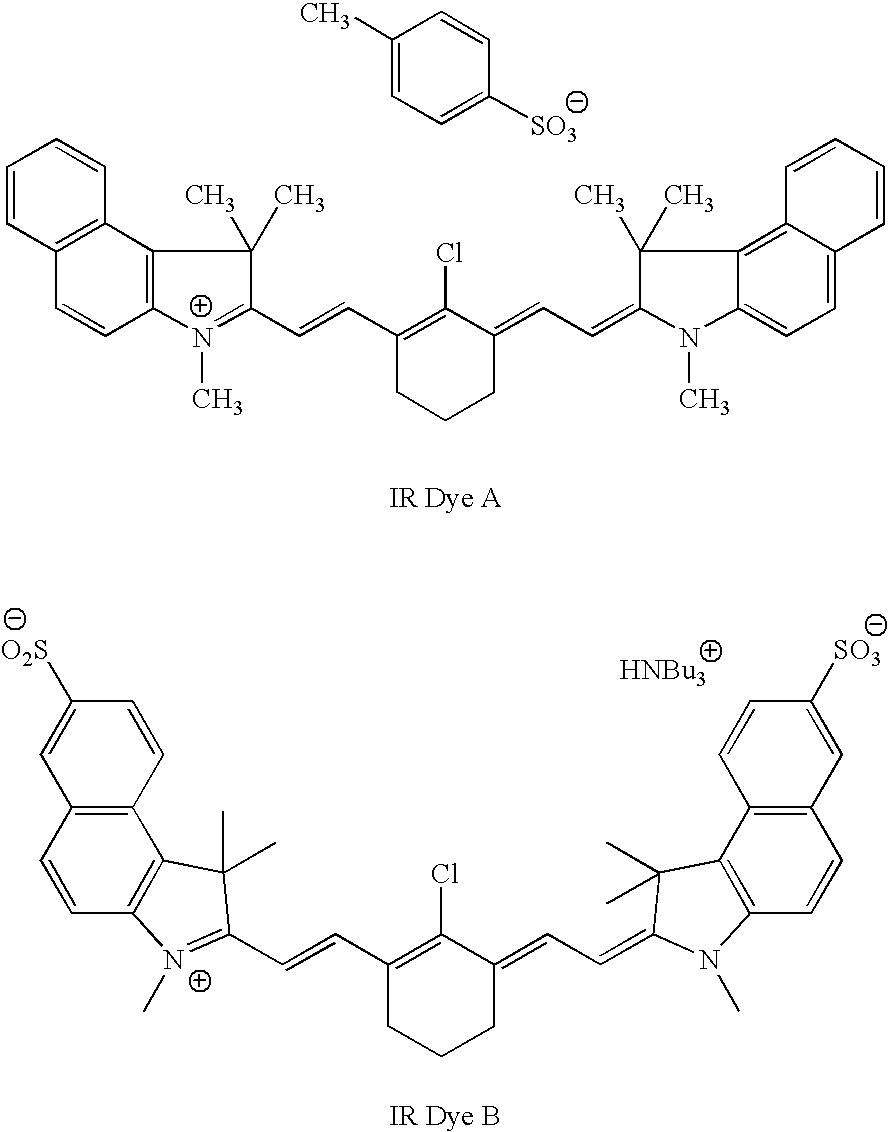Method for developing multilayer imageable elements
a multi-layer, image-forming technology, applied in the field of lithographic printing, can solve the problems of inconsistent tone images, unacceptable variations in dot percentages throughout the developer loading cycle, and liable to fatten halftone dots with plates
- Summary
- Abstract
- Description
- Claims
- Application Information
AI Technical Summary
Benefits of technology
Problems solved by technology
Method used
Image
Examples
example 1
[0080]SWORD® Excel printing plate precursors were imaged with 830 nm radiation using an internal test pattern on a CREO® 3230 Trendsetter (120 mJ / cm2, 250 rpm, 13.25 W laser power). The internal test pattern contained 0, 2, 5, 10, 20, 30, 40, 50, 60, 70, 80, 90, 95, 98 and 100% dot images. Imaging was carried out using CREO® Staccato (FM) 10 micron and 20 micron screen ruling at about 94.5 lines per cm (200 line pairs per inch) and a test pattern using the more familiar about 113.4 lines per cm (240 line pairs per inch), round dot AM screen rulings.
[0081]A Unigraph Compact Microtec 60 desktop plate processor (Unigraph Equipment, Thetford, UK) was modified such that developer could be pumped from a container, through a pump (Model AC-56-Md, March Manufacturing, Glenview, Ill., USA) and valve, into a spray bar (8 holes, about 25.4 mm (1 inch) apart). Low levels of developer can be dribbled onto the incoming imageable element. The developer spreads over the surface of the imageable ele...
example 2
[0092]Example 1 was repeated, except that (1) SWORD® Ultra printing plate precursors were used and (2) the precursors were imaged with 830 nm radiation using an internal test pattern on the CREO® 3230 Trendsetter at 105 mJ / cm2 (250 rpm, 11.5 W laser power).
[0093]The imaged imageable elements were processed using Goldstar™ developer in the processor described above. The results are shown in Table 2.
[0094]
TABLE 210 Micron Staccato Screen20 Micron Staccato Screen240 lpi, round dot AM Screen0.58 m20.58 m20.58 m2 of0.58 m2of plate0.58 m2of plateplateof plateprocessedof plateprocessed0.58 m2processedTheoreticalprocessed2 weeksDotprocessed2 weeksDotof plate2 weeksDotDoton day 1laterdifferenceon day 1laterdifferenceprocessedlaterdifference(%)Measured Dot (%)Measured Dot (%)Measured Dot (%)0000000000223112123154514515501010122101111010020222112122119201303231132320293014043430424203941250535305252050511606363062631605117073721727317071180838218282080811909292091921909119597961969609495198999...
example 3
[0095]SWORD® Excel printing plate precursors were imaged with 830 nm radiation using an internal test pattern on a CREO® 3230 Trendsetter (120 mJ / cm2, 230 rpm, 11.5 W laser power). The internal test pattern contained 0, 2, 5, 10, 25, 35, 40, 50, 60, 70, 80, 90, 95, 98 and 100% dot images. The imagewise exposure was carried out using a CREO® Staccato (FM) 10 micron and 20 micron screen ruling at about 94.5 lines per cm (200 line pairs per inch) and a test pattern using the more familiar about 113.4 lines per cm (240 line pairs per inch), round dot AM screen rulings.
[0096]The imaged imageable elements were developed using 956 developer in an apparatus similar depicted in FIG. 1. A Unigraph Compact Microtec 60 desktop plate processor (Unigraph Equipment Ltd, Thetford, UK) was modified such that developer could be pumped from a container, through a pump (model AC-56-Md, March Manufacturing Inc., Glenview, Ill.) and valve, into a slot coater 1. Developer was applied to the complete face ...
PUM
| Property | Measurement | Unit |
|---|---|---|
| temperature | aaaaa | aaaaa |
| temperature | aaaaa | aaaaa |
| weight ratio | aaaaa | aaaaa |
Abstract
Description
Claims
Application Information
 Login to View More
Login to View More - R&D
- Intellectual Property
- Life Sciences
- Materials
- Tech Scout
- Unparalleled Data Quality
- Higher Quality Content
- 60% Fewer Hallucinations
Browse by: Latest US Patents, China's latest patents, Technical Efficacy Thesaurus, Application Domain, Technology Topic, Popular Technical Reports.
© 2025 PatSnap. All rights reserved.Legal|Privacy policy|Modern Slavery Act Transparency Statement|Sitemap|About US| Contact US: help@patsnap.com



